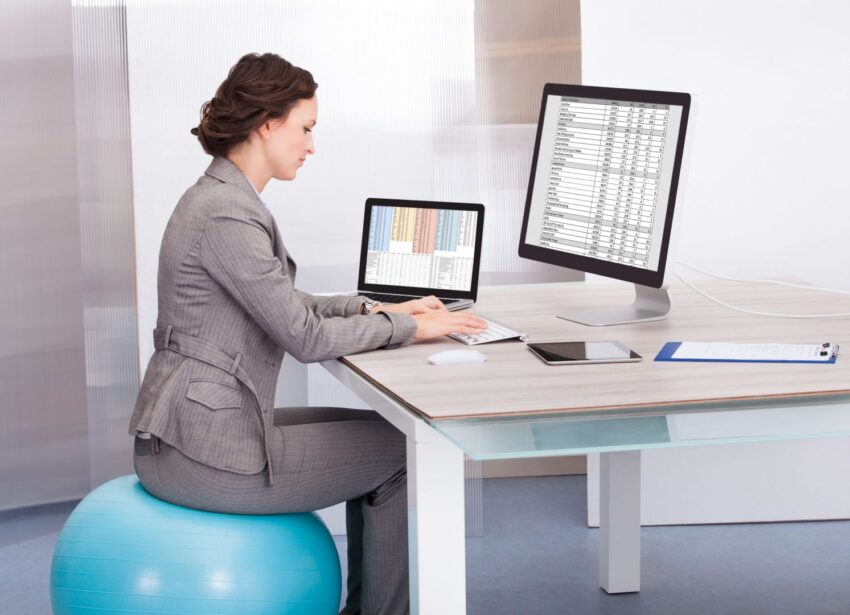By Erin M. Friend, P.T., D.P.T., C.E.A.S.
Ergonomics is the science of blending the workstation to the worker in order to increase health and productivity and decrease work-related musculoskeletal disorders.
Records show that ergonomics dates back to the 5th century when Hellenic civilizations used ergonomic principles to design tools and workplaces. Similarly, Hippocrates, the father of Medicine, described how surgeons’ workplaces should be arranged. 3 Today, as technological advances such as laptops, tablet computers, and cell phones are becoming increasingly popular ways to conduct business on the go and as musculoskeletal disorders are on the rise, ergonomics is in even more demand.
Importance of Implementing Ergonomics for Computer Workers
Poor workstation setup and posture leads to pain, dysfunction, and tissue breakdown. Ultimately, this cascading event increases a worker’s number of sick days, decreases productivity, and increases worker compensation costs. Every year, companies are spending an exorbitant amount on worker compensation claims due to worker injuries exceeding the cost of group health care insurance.2
The Occupational Health and Safety Administration (OSHA) set minimal standards that all employers should follow to decrease the risk of injury to workers. Even with guidelines in place, the reported injury rates for work-related musculoskeletal disorders in the industrial arena are high. Statistics for musculoskeletal disorders in the office environment are less known.4 A three-year study completed by Gerr et al. in 2002 reported that 50% of computer users in North America develop some type of musculoskeletal symptoms during their first year on a new job.4
Work-Related Musculoskeletal Disorders
Work-related musculoskeletal disorders (WMSDs) is a collective term that describes disorders relating to muscles, tendons, and nerves, typically caused by awkward postures and potentially painful during work or rest.5 Movements that increase a person’s chance of developing a musculoskeletal disorder, when constant (2 hours or more) or repetitive in nature, include bending, straightening, gripping, holding, twisting, clenching, and reaching.2,5 Individuals will not injure themselves just by performing these motions once or twice a day, or if they take a break during the day. Common syndromes related to WMSDs include tendonitis, muscle strain, cervicothoracic dysfunction, thoracic outlet syndrome, low back pain, and carpal tunnel syndrome.4
Efforts are being made by OSHA and researchers to fine-tune guidelines and improve standards for workers in all industries, including computer workers. Computer workers increasingly suffer from musculoskeletal disorders related to mental and physical fatigue, poor physical fitness levels, static work and home offices, and longer working hours.2 The workforce as a whole is also aging as 25.6 million workers are currently over age 55, and it is predicted that in 2014, 33% of the workface will be over 50 years old.2
Poor Posture and its Effects on the Body
Posture is defined as “the relative position of the body at any one period of time.” 6 Correct posture or neutral posture is a position in which minimal stress is applied to the body’s muscles, tissues, joints, and ligaments, providing the most energy efficient movement.7
The central nervous system (CNS) begins to make musculoskeletal adaptations to the postures and movements performed most often. These muscular imbalances cause some muscles to be in a constant state of contraction while other, opposing muscles remain weak and overstretched, which leads to pain.8,9 To better understand how the CNS controls our movements, do this quick experiment. Cross your arms or clasp your hands together and see which is on top. Now do that a couple times and you will find that it is the same hand or finger on top each time. We are creatures of habit. Now do the same things again, but purposefully make sure the other hand or finger is on top this time. How does it feel? It might feel awkward or maybe even uncomfortable. This is what happens when you try to correct your poor posture to achieve better posture. You simply aren’t used to good posture, but you can improve it. In addition to creating new muscle patterns with poor posture, the body’s fascial system also adapts.
Fascia is tough connective tissue that supports and lubricates every muscle and organ in the human body. However, if poor posture, trauma, or inflammation is involved, the fascia will bind down and create more fascia in response to stress or demand. When fascia binds down, extra pressure is also being placed on nerves, blood vessels, bones, and organs.10, 11 For instance, a right hand dominant person will have more fascia over the central and right side of the sternum or breastbone. This means the chest area of a right-handed person may be tighter or more contracted, possibly causing rounded shoulders if poor posture is evident. In addition to creating stress on the fascial system, poor posture can also lead to stress on the ligaments and joint capsules. Ligaments and joint capsules are formed by collagen bonds, which begin to breakdown with a 5% elongation and fail at 7% elongation, causing chronic deformation.8
The most common examples of poor posture seen in computer workers are a forward head, rounded shoulders, and slouched spine. Therefore, when one is sitting in this awkward posture, it is not uncommon to see tightening of the fascia and muscles of iliopsoas, pectineus, occipitals, pectoralis, trapezius, sternocleidomastoid, levator scapularis, adductors, and piriformis.8 Eye strain, difficulty breathing, poor circulation, and headaches are also a result of poor posture.
What is a Good Posture for Computer Users?
To decrease a person’s chance of creating breakdown in the body, proper posture and desk setup is important. A good workstation is one that has an adjustable chair, mouse/keyboard and computer monitor.
Chair Setup
When sitting, a person’s bottom needs to be all the way to the back of the chair with their feet resting firmly on the ground and feel they have equal pressure on the balls of their feet and their ischial tuberosities (sitz bones). A good chair is one in which the seat depth is adjustable to allow 2-3 fingers from the back of the knees to the front of the chair. The lower back and upper back should be well supported by the back of the chair. A lumbar support isn’t always adjustable, but if it is, the support needs to be placed in the small of the back. If using the armrests of the chair, a person needs to able to adjust the height, width, and pivot for proper arm placement when typing.
Keyboard and Mouse Setup
Arms need to be relaxed and resting by the person’s side with elbows between 90-110 degrees. This is also where the keyboard and mouse need to be placed. Wrists and hands need to be in a neutral or slightly flexed position as if you were playing the piano. Typically, the legs of the keyboard do not need to be up as they cause extension of the wrist. Gel pads in front of the keyboard and mouse also decrease pressure on the carpal tunnel and bring hands into a more neutral position. If you move your arms in and out from this position, it is where 90% of your daily work or accessories’ (coffee, phone) need to be placed. When you reach out beyond an arm’s distance, posture must change to reach the object.
Computer Monitors
The computer monitor is placed at an arm distance away, typically 18-20” for standard monitors. For larger monitors, place it another couple inches away. The height of the monitor is where your eyes are at center to top third of the screen with your head looking forward. A simple monitor riser or books can be added if your screen is not adjustable. For those who use bifocals or progressive lenses, the monitor should be set to where you are looking through the bifocal/progressive part of the lenses.
Additional Setup
When in-putting data, documents need to be placed on a person’s dominant eye side and monitor level. To determine your dominant eye, make a circle with your fingers and place an object in the center with both eyes open. Now, close one eye, open, then close the other eye. Whichever eye was open when the object remained in the center is your dominant eye.
Frequent phone use also leads to dysfunction. For long phone conversations, utilize a speaker phone or purchase a headset to decrease neck pain. Keep cell phone or touch screen computer use to minimum unless using wireless technology or the device is placed at eye level.
Laptops are convenient to use during meetings, travel, and telework due to their size and portability. On the contrary, laptops are not the best for posture as this article has hopefully pointed out. The quickest and best fix for using your laptop is to place the laptop at eye level and use a detachable keyboard and mouse.
Good Posture, Now What?
Now that you are on your way to maintaining good posture, keep in mind it takes about three weeks to get used to any new changes. As mentioned earlier, we are creatures of habit since we are controlled by the central nervous system. As you begin to adjust to your new posture, you may feel sore and achy, but after about three weeks, reverting to your old posture will begin to feel uncomfortable.
Take a Break and Change Positions
Mini breaks are needed throughout the day to decrease eye fatigue, prevent physical and mental fatigue, and decrease risk of tissue breakdown.4 Every hour, get up, move around, and take a five minute break to stretch or do an exercise before resuming work. Work-break cycles are just as integral a part of performance and health as workstation setup and posture.
Conclusion
As the article points out, posture plays an important role in overall health and well-being. The key to trying to decrease risk of developing a musculoskeletal disorder is getting assistance or treatment when you are feeling fatigued, especially prior to onset of pain. Posture is not only important when sitting at your desk and working on the computer, but when you perform activities of daily living or extracurricular activities.
A physical therapist is trained and well-versed in how the human body moves and is a specialist in soft tissue dysfunction and treatment. They play an important role in recognizing poor posture and work with patients to correct their posture. If you have any concerns about how your workstation is set up and believe it could be contributing to your pain, talk to your physical therapist. He or she may refer you to a physical therapist that is a certified ergonomic assessment specialist to conduct an onsite assessment of your workstation at your office, and make additional recommendations of equipment that will allow you to use good posture.
References
- Boudreau LA, Wright, G 2003. Ergonomic considerations for a patient presenting with a work-related musculoskeletal disorder: a case report. J Can Chiropr Assoc 47(1): 33-38
- Porter R. 2008. Back School of Atlanta. Ergonomics: Practical Applications. Manual
- Ergonomics. Retrieved January 12, 2011 from http://en.wikipedia.org/wiki/Ergonomics
- Taylor K Research Paper on Repetitive Strain Injury and Breaks. 2002.
- Canadian Centre for Occupational Health and Safety. 2005. Work-related Musculoskeletal Disorders. Retrieved January 12, 2011 from http://www.ccohs.ca/oshanswers/diseases/rmirsi.html
- Kolber M. 2008. Posture: What about it? Retrieved February 9,2011 from http://www.spineuniverse.com/wellness/ergonomics/posture-what-about
- Good Posture. 2007. Olin Health Center. Michigan State University
- McKeevor B. 2010. Functional Ergonomics: Successful Interventions and Preventative Solutions for Work-Related Pain and Injuries.
- The Healthy Back Institute. 2003-2010. Muscle Balance Therapy. Retrieved February 9,2011 from http://www.losethebackpain.com/treatments/musclebalancetehrapy.html
- Barnes J. Myofascial Release. What is Fascia? Retrieved February 1, 2011 from http://www.myofascialrelease.com
- McKeevor S. What is fascia and how does Bowen Therapy affect it? Retrieved from http://biointegrativewellness.wordpress.com/



